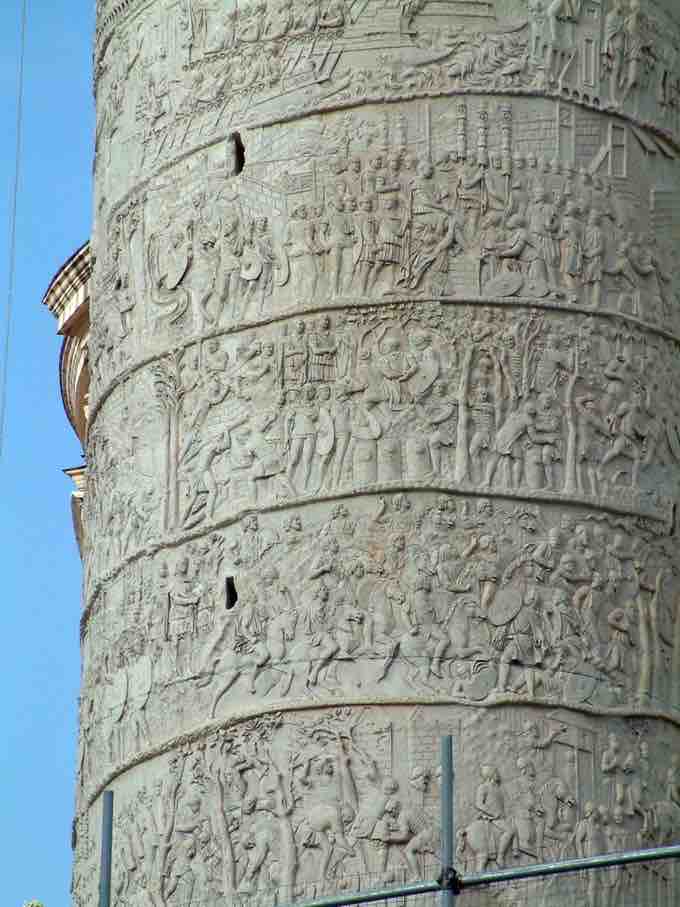Imperial Memorial
Trajan was born in Spain and rose to prominence in the Roman army during the reign of Domitian. He was a popular general who was adopted by the Emperor Nerva as son and heir after Nerva realized the he needed chose a successor who was liked by the people. During Trajan's reign of nearly twenty years, from 98 CE to 117 CE, the Roman Empire reached its greatest territorial range. Trajan established large building programs both in Rome and throughout the empire.
Column of Trajan
Trajan and his architect Apollodorus of Damascus designed and built a large forum complex in the center of Rome. Standing between the libraries of the Forum of Trajan is a 128 foot tall victory column, known as the Column of Trajan. It stands on top of a large pedestal carved with a relief of the spoils of war. The pedestal later served as a tomb for Trajan's ashes upon his death and deification. He is notably the first emperor to be buried inside the pomerium. In a spiral relief that wraps around the column, from its bottom to its top, is a 625-foot frieze depicting Trajan's two military campaigns against the Dacians.
Column of Trajan
Rome, Italy. 112 CE.
The frieze depicts over 150 episodes with more than 2,500 figures. The scenes show the Roman army preparing for and war, including scenes of moving the army, building fortifications, Emperor Trajan addressing the troops, battles, and the eventual surrender by the Dacians. Only one quarter of the narration depicts battles, while the remaining panels depict scenes of preparation and other activities. The heavy emphasis on preparation, instead of battle, emphasizes the Romans' organization and the power behind the army. The visual narration is depicted in low relief (bas relief) and relies little on naturalistic detail, preferring to show some scenes in multiple perspectives and with figures on different ground lines. Important characters, such as Trajan, reappear throughout the frieze and are easily identified. Trajan himself appears 59 times, leading his troops as the head of the army and the empire. With the exception of the appearance of a few Victory figures and a river god, the Romans and Trajan are shown conquering the Dacians under their own power, though their own superiority over their enemy, without the help of divine intervention.

Detail from the Column of Trajan
Detail of five registers or bands from the Column of Trajan.
Trajan's victory column was originally topped by an eagle and later with a statue of Trajan. The statue of Trajan eventually disappeared and was replaced in the sixteenth century by a bronze statue of St. Peter. Scholars have recently called the legibility of the figures into question. Because of the column's location, nestled between the libraries and the basilica of the Trajan's Forum, the scenes, which are carved in low relief, are small and hard to read. It is uncertain how much of the column's relief Romans would have been able to see. There is some speculation whether knowledge of the idea of the narrative was more important than being physically able to read the narrative.
The Column of Antoninus Pius
Antoninus Pius (r. 138-161 CE), the first of the Antonine emperors, was the adopted son of Hadrian. His heirs Lucius Verus and Marcus Aurelius had a column erected to him on the Campus Martius, the base of which survives today. On two of its sides is an identical scene of a military decursio depicting cavalry men parading around soldiers, two of whom hold standards. The relief carvings are high enough to protrude from the sides and be visible when viewing the non-decursio side of the pedestal. It depicts each figure from a ground-level perspective while showing the circular parade from a bird's eye view.
Pedestal of the Column of Antoninus Pius.
Decursio scene. 61 CE.
On one of the other two sides is a dedicatory inscription. On the opposite panel is a scene of the apotheosis of Antoninus Pius and Faustina. The scene depicts a large winged figure named Aion (Eternity) carrying the couple, surrounded by two eagles, to heaven. Two figures look on from the ground. One is a personification of the Campus Martius, lounging on the ground with an arm around Augustus's sundial obelisk, the location where the ritual of deification occurred. The other is a personification of Rome, who appears as a woman wearing armor. She salutes the emperor and empress during their apotheosis, while leaning on a shield depicting the she-wolf suckling Romulus and Remus.
Pedestal of Column of Antoninus Pius.
Apotheosis of Antoninus Pius and Faustina. 61 CE.
The Column of Marcus Aurelius
A victory column was also erected for Marcus Aurelius (r. 161-180 CE). This column is modeled on Trajan's column and was originally erected on the Campus Martius between the Temple of Divine Hadrian and the Temple of Divine Marcus Aurelius. A relief frieze encircles the column and depicts Marcus Aurelius's military campaigns at the end of his life in Germania.
Column of Marcus Aurelius
Detail of five bands from the column. 193 CE.
Despite the similar military scenes, the artistic style of the Column of Marcus Aurelius differs greatly from the Column of Trajan. The figures in this column are stockier and their proportions are distorted. The extra-large heads and deep relief carving were utilized so that the figures were easier to see from the ground than those on Trajan's column. The military strength of the empire is emphasized more so than on the Column of Trajan where the majority of the scenes depict the preparation for battle, instead of the battles themselves. The new style, high relief, and military emphasis demonstrates the changing priorities and social-political attitudes of the period.